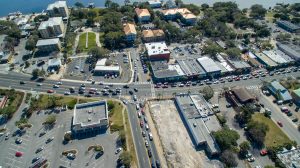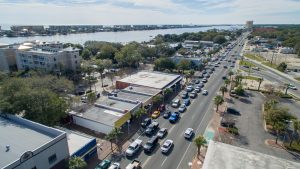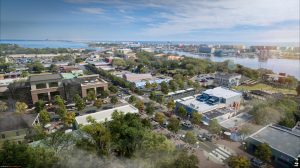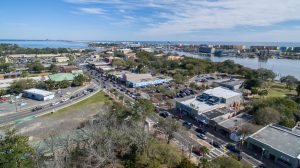By Michael Beedie, City Manager, City of Fort Walton Beach
The Downtown FWB Challenge
Downtown Fort Walton Beach is at a crossroad. Over the last 15 years, the Okaloosa-Santa Rosa County region has experienced significant population growth due to an influx of military families from Eglin Air Force Base and Hurlburt Field as well as the further development of the region’s tourism industry. However, this population growth has been concentrated in the bedroom communities of Navarre, Crestview, and Niceville.
The City of Fort Walton Beach finds itself with a fortuitous opportunity to transform Downtown FWB into a retail and entertainment destination that offers residents and visitors from around the region with a unique shopping, dining, and family-centric entertainment experience. While the existing downtown offers some of these experiences already, it is greatly limited in its ability to become a premier Emerald Coast destination by current transportation, parking, access, and pedestrian circulation issues.
Miracle Strip Parkway (US 98) is the historic heart of Fort Walton Beach. However, the exceedingly high levels of commuter traffic along this critical transportation corridor has bisected downtown and limited all modes of transportation. These mobility issues have restricted growth by creating a disconnected downtown environment that limits destination retail, entertainment, and higher-density residential redevelopment.
The effect of increasing traffic volumes along US 98 on the downtown environment cannot be overstated. The Level of Service (LOS) is used to analyze highways by categorizing traffic flow and assigning quality levels of traffic based on performance measure like speed, density, etc. The LOS for the downtown segment of US 98 currently receives a “D” ranking with traffic routinely stacking through the intersections in the downtown area during peak travel periods. This routine traffic gridlock paralyzes downtown mobility and restricts the daily functions of business owners and residents.
The Time is Right…
Today, there is a confluence of major, once-in-a-generation, planning and design projects that are currently underway in and around the FWB downtown that are catalytic in nature and can be developed in conjunction with the Downtown Master Plan:
- Brooks Bridge Replacement (FDOT)
- Santa Rosa Sound Alternate Crossing Study (FDOT)
- CRA Boundary Evaluation & Plan Update
- Commerce and Technology Park Master Plan
- Fort Walton Beach Landing Park Renovation
- Historic Gulfview Hotel Relocation
In addition to these publicly-led planning and design projects, several private-sector redevelopments are underway. In short, the downtown “iron is hot”; therefore, the time to “strike” with a transformational vision of downtown Fort Walton Beach is now.
The replacement of Brooks Bridge and the development of the Santa Rosa Sound Alternate Crossing Study presents the City with a tremendous opportunity to impact the realignment of US 98 and reclaim Miracle Strip Parkway as a traditional, pedestrian-oriented, “Main Street” corridor. By doing so, downtown has an opportunity to redevelop into a walkable community, encouraging higher-density, mixed-use development that creates a live, work, and play environment supported by local businesses.
The Community Vision
In order to begin the redevelopment process, the City commissioned Matrix Design Group to develop the Downtown Fort Walton Beach Master Plan. The planning process utilized public engagement strategies that included community surveys (businesses and residents); stakeholder meetings; a market condition summary; and Strengths, Weaknesses, Opportunities, and Threats (SWOT) Analysis. These strategies identified the key issues affecting the downtown and opportunities for improvements.
Early in the planning process, it was determined that transportation was the central focus of the Plan. As such, a series of Transportation Alternatives was provided for further stakeholder evaluation. These alternatives were developed with input from City staff, Downtown businesses and property owners, the Downtown Fort Walton Beach Organization, the Greater Fort Walton Beach Chamber of Commerce, the Florida Department of Transportation, the Economic Development Council of Okaloosa County, and regional developers.
A total of six Transportation Alternatives were developed that explored a range of minimal to maximum improvements. After numerous stakeholder meetings, a preferred alternative was selected as the Preferred Alternative. On November 15, 2017, City Council unanimously approved the Preferred Alternative with great community support.
The Preferred Alternative routes through traffic north of the downtown area, creating a larger area for redevelopment and a more pedestrian-friendly “Main Street” environment.
Next Steps…
The City now is tasked with requesting to add the Downtown Transportation Preferred Alternative to the Okaloosa-Walton Transportation Planning Organization’s (OWTPO) Long Range Transportation Plan (LRTP) for further study and analysis.
The LRTP is a blueprint for maintaining and enhancing the regional transportation system by identifying roadway, transit, bicycle and pedestrian, intelligent transportation systems (ITS), and other improvements needed over the next 25 years.
In addition to adding the study to the LRTP, the City will work with the OWTPO to amend the five-year Capital Improvement Plan to include this project and provide more near-term funding for further study.
If approved by the OWTPO, a Project Development and Environment (PD&E) Study would further refine the proposed US 98 realignment, more fully analyze the potential impacts, and provide continued opportunity for public and agency involvement before a recommended alternative is developed. The OWTPO and FDOT would develop a scope of work for the PD&E Study which could range in fees from $1M – $1.5M to include the full spectrum of consulting services to bring the preferred alternative to final design.
The ultimate goal is to coordinate the design and construction of the Downtown Transportation Preferred Alternative with the Brooks Bridge Replacement Project, which is scheduled to begin construction in 2021-22.









